Chronicle of space super heavyweight. Part 2. "Park" reusable period
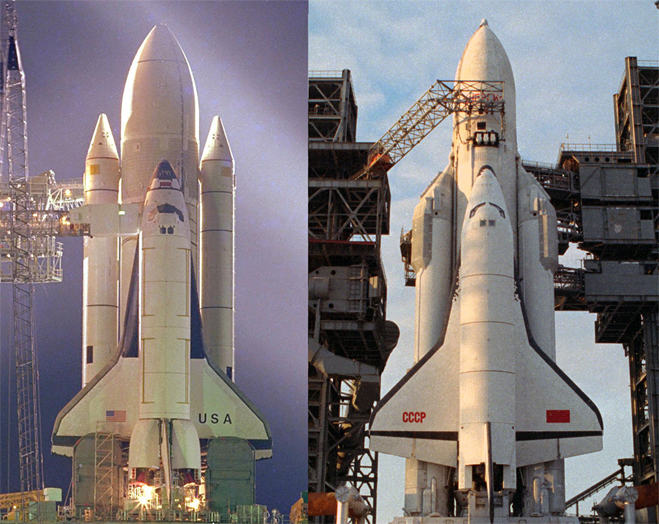
In 1971, a year before the last lunar expedition of the Apollo spacecraft, Rockwell, on behalf of NASA, began developing a new reusable space system. The program called “Space Shuttle” (Space Shuttle), was presented to the US government as commercial, and had to use the achievements of the previous, purely “ideological” program Apollo.
At the same time, at the other end of the Earth, Soviet experts noted that the Space Shuttle system has no significant advantages over disposables. However, the project was considered viable, as an addition to existing transport systems.
Against the background of a general uncertainty about the goals of the American project, it was decided to develop its reusable ship to ensure military parity with the United States.
According to the adopted project of 1972, the Space Shuttle system consisted of three main parts:
')
1. Two side solid-propellant rocket boosters of the Thiokol company, played the role of the first stage, making up 60% of the total weight of the space system (and giving 80% of the total thrust).
Each TRU (SRB) unit weighed 580 tons each and with a starting load of 1200 tons (242s output pulse), burned 500 tons of ammonium perchlorate (oxidizer), aluminum (fuel) and iron oxide (catalyst) in total, up to a height of “shot” in 45 km . After that, each of the blocks with a height of 50 m and a diameter of 3.7 m, made a smooth landing in the ocean with the help of parachutes. In practice, 10 times the use of TRU blocks was allowed.
Shooting side blocks TRU (SRB) and their splashdown
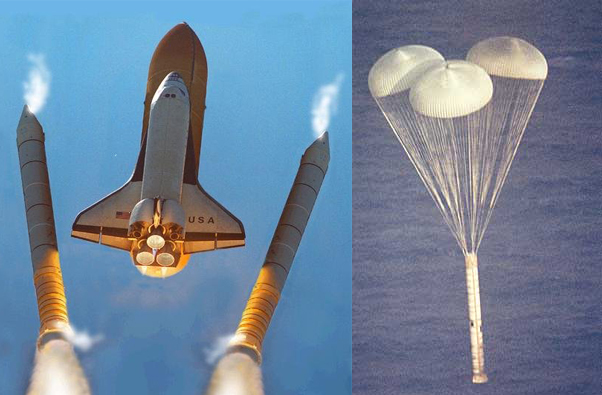
2. Next, the baton was taken over by three liquid rocket engines (LRE) of the main component of the reusable system - Orbiter (or Shuttle). This joint offspring of the companies Rocketdyne, Rockwell and Boeing weighing about 80 tons (without payload), 37 meters long and wingspan of 24 meters, was the first history of a reusable spacecraft. The orbiter could have a crew of up to 7 people, and in a cargo compartment with dimensions of 18m / 4.6m, output up to 25t to a low near-earth orbit (or return to the earth 14t).
Technological curiosity associated with the cargo compartment of shuttles
Initially, the size of the cargo compartment of NASA was imposed by the US Department of Defense, presumably under the dimensions of promising optical reconnaissance satellites in real time - the KH 11 series (Keyhole - Keyhole). The optics of these satellites are considered “parent” in relation to the famous Hubble orbital telescope.
Soviet specialists, who learned about the KH 11 only in the late 70s, were very concerned about the similarity of the cargo compartments of the shuttle and the dimensions of the Soviet orbital stations "Almaz" and "Salyut". This had a great influence on the choice of dimensions of the cargo compartment "Burana". By the way, the US military realized that NASA "slightly" exaggerated the commercial benefits of the shuttles (together with the stated frequency of launches of 20 / year), launched their satellites mainly with the help of the Titan PH. The only known case of the launch of the KH 11 series reconnaissance satellite by Atlantis (STS 36) took place on February 28, 1990.
Soviet specialists, who learned about the KH 11 only in the late 70s, were very concerned about the similarity of the cargo compartments of the shuttle and the dimensions of the Soviet orbital stations "Almaz" and "Salyut". This had a great influence on the choice of dimensions of the cargo compartment "Burana". By the way, the US military realized that NASA "slightly" exaggerated the commercial benefits of the shuttles (together with the stated frequency of launches of 20 / year), launched their satellites mainly with the help of the Titan PH. The only known case of the launch of the KH 11 series reconnaissance satellite by Atlantis (STS 36) took place on February 28, 1990.
With the help of three main sustainer hydrogen engines RS 25, a total of 540 t, a resource of 1200 s and a 363 s wake (450 s in the void), the Orbiter burns for 8.5 minutes (6.5 after separating the TRU) 700 t of fuel from the external Fuel The tank (the third element of the system with dimensions of 47 / 8.4 m) to the height of its compartment is 105 km. Next, the Orbiter went to a given orbit, using the energy of its own orbital maneuvering fuel system (OMS), in order to avoid TB being put into the shuttle's orbit.
The total thrust of all engines of the system at launch is 2900 tons, the mass of the system itself is 2030 tons.
Installation of RS 25 engines on Orbiter

Reusable system diagram

The first flight of the Space Shuttle space system, April 12, 1981. Tragically famous shuttle Columbia
One of the first Soviet projects of the reusable vehicle, MTK-VP , could be used together with the N 1 (still left) rocket that was still being run in (left), or with the Glushko block missile after the H 1 project was closed in the mid-70s (right).
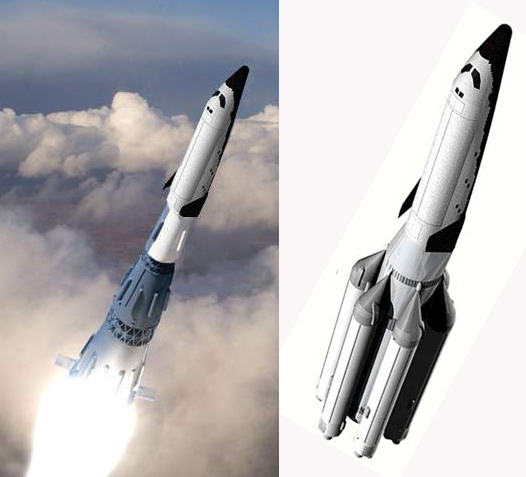
However, due to the small area of resistance to air flow when entering the atmosphere (compared to the weight of the ship), thermal protection had to “tolerate” too high temperatures. General designer of reusable Soviet ships G.. Lozino-Lozinsky called such a system "half-time" because of the too high volumes of inter-flight operations.
In parallel with this, in 75, it was decided to go the shortest way and completely copy the American system, which took shape in the OS 120 project .
However, due to the fact that the Soviet project was mainly for military purposes, OS 120 had two major drawbacks:
1. The development of such a technology was too time consuming for the Soviet space program, and required additional time, a significant lag for the military was unacceptable.
2. The orbital ship was the only large-sized “passenger” for such an ultra-heavy and techno-intensive system. Converting it into a separate PH in the future required additional time and money.
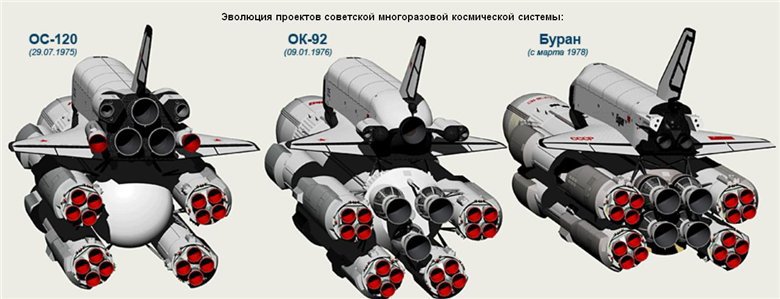
Starting from project OK 92 at 76th, and until approval of the final scheme of a reusable system in 78 ( with the Buran shuttle developed by Molniya), 4 first-stage side accelerators (Block A) “pereobulsya” from RD 123 with a load of 600t , 4 forced RD 170, weighing 9.7 tons, 740 tons each, and with a fantastic (for a kerosene rocket engine) y. impulse 310s. at sea level! All four units with dimensions of 38 / 4m had to work 140s, during which kerosene / oxygen fuel was “burned out” with a total weight of 1230t, up to a height of 53km, giving the second stage with a load an acceleration of 1.8 km / s. Although each RD 170 engine was certified for 10-fold use, all 4 blocks, like the entire "energy", were disposable.
The blocks of the first stage of the PH "Energy"

Multichamber engines RD 171 (on the left, version RD 170 for Zenit) and RD 108 (on the right, the second stage of the Soyuz launch vehicle) carry a kind of technical “signature” of their relatives in the 476 / Energomash design bureau. Glushko
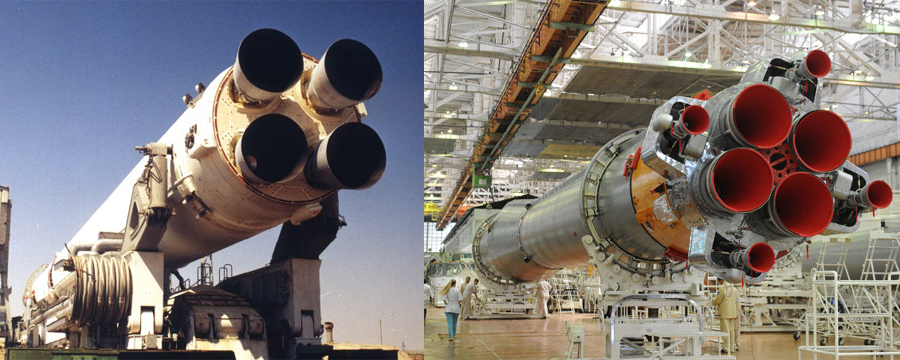
Three hydrogen fuel rocket engines 11D122 (traction 200-250t) were also replaced with 4 RD 0120 with a weight of 155-200t, and a 353-455s impulse (sea level-vacuum) developed by the Voronezh KBCH. Rearranging them from the tail of the ship under the fuel tank, although it put an end to repeated use, but greatly simplified the production of engines and improved the aerodynamics of the ship. But most importantly, it allowed the creation of a completely new and universal LV of the extra-heavy class “Energy”.
Soviet hydrogen rocket engines 0120
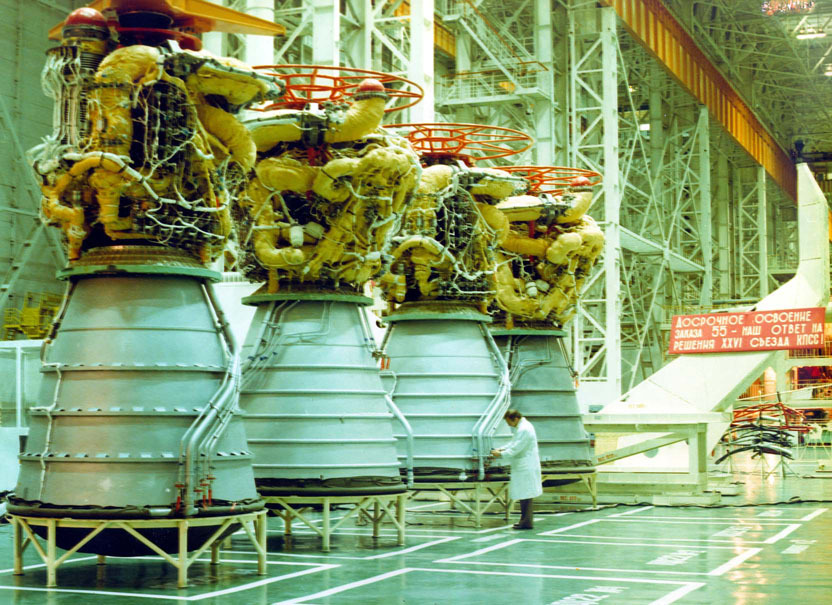
The resulting block of the second stage, “C”, had a height of 57m, a diameter of 7.7m, and retained a supply of fuel similar to the TB Space Shuttle - 700t of oxygen and hydrogen. The stage is separated for 480 seconds of flight, reaching a height of 115 km. Further removal of the load is provided by the orbital ship’s own engines or the third stage with a payload.
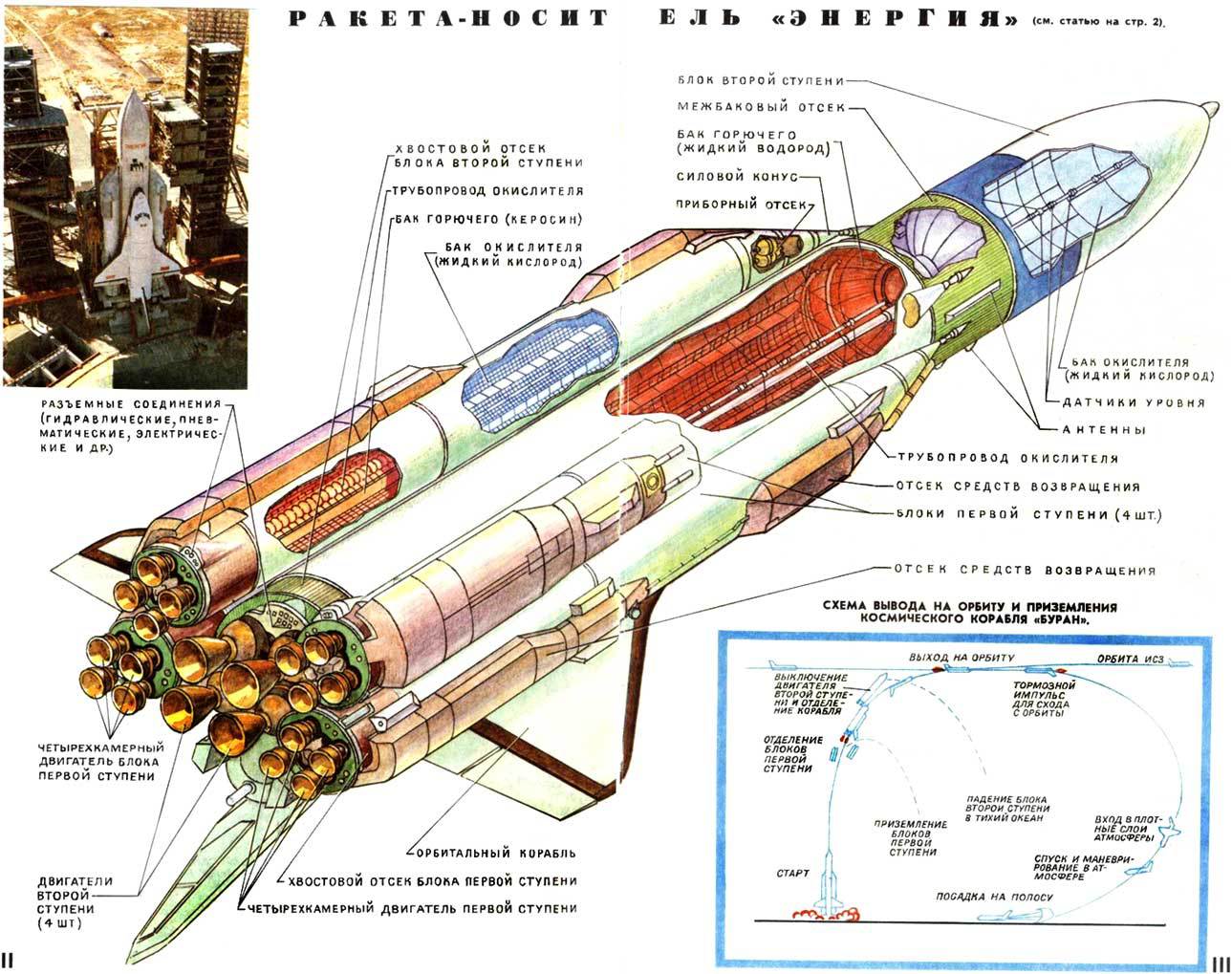
The rocket "Energy" was part of a universal space system. So, selecting a certain number of blocks of the first stage and with a change in the volume of tanks of the second stage, it was possible to achieve the desired capacity in a relatively short period of time.
The total weight of the LV "Energy" was 2400t, the total thrust of all engines at the start - a record 3550t! The first flight of the rocket was made on May 15, 1987 from the Baikonur cosmodrome with a large-sized mockup of the Polus satellite
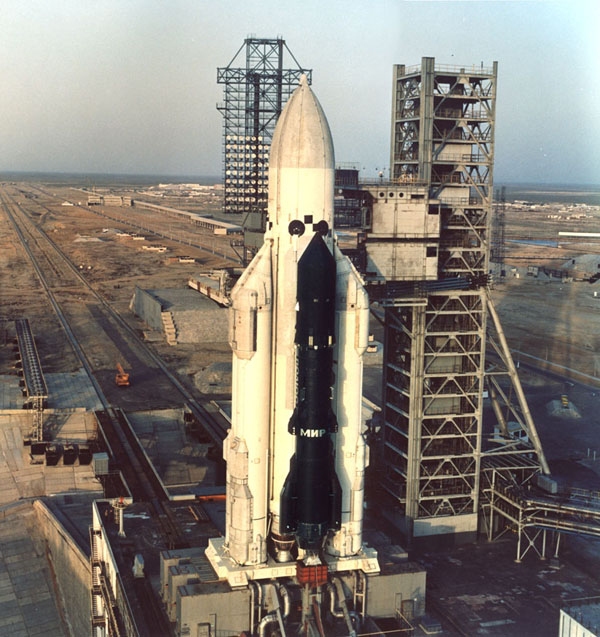
The base variant allowed using one of the blocks as the first stage of the Zenit launch vehicle (still in use) with a loading capacity of 15 tons per supporting low orbit. A selection of two blocks made it possible to output 30t of the payload ( PH “Energy M” ).
Full-scale mock-up of the “Energy M” LV at Baikonur
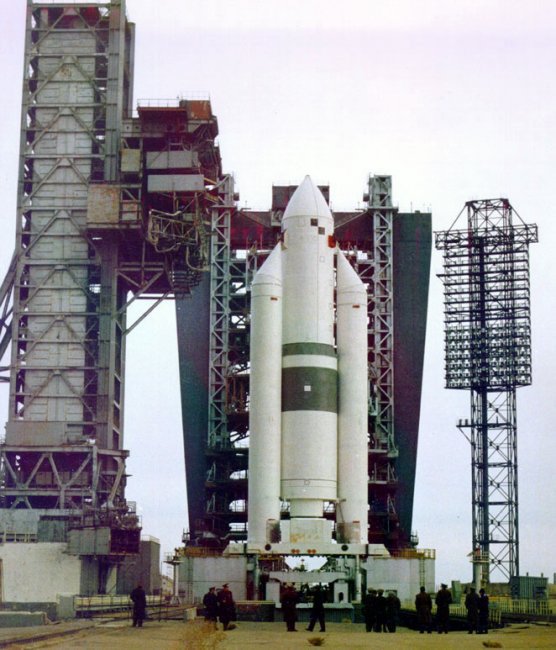
A selection of 8 reinforced blocks of the first stage with forced RD 170 engines (up to more than 800 tons of traction each!) And the second stage of the Energy M as the third stage allowed the projected rocket, the giant Vulcan weighing 3,800 tons, to be put into 170 tons !

The orbital Soviet shuttle itself, despite the radical alteration of the OS 120 basic project, generally retained the weight and dimensional parameters of its American "fellow" - 80 tons, with a length of 35 meters, a wingspan of 24 meters and a cargo compartment size of 18 meters / 4.6. The mass of the payload is 30 tons, the mass of the returned load is 14 tons.

Details of the flight system "Energy-Buran"
Well characterized the transformation of the project OS 120 in "Energy-Buran", one of its designers G.. Lozino-Lozinsky :
“Copying, (...), was, of course, perfectly conscious and justified in the process of those design developments that were carried out and in the process of which many changes were made to the configuration and design, as already indicated above. The main political requirement was to ensure the dimensions of the payload compartment, the same as the “Shuttle” payload compartment. ”
In total, according to the Space Shuttle program, 5 orbiters were built: Columbia, Challenger, Discovery, Atlantis and Endeavor. The first flight of the program was made on April 12, 1981 (the shuttle Columbia). The last flight was made by Atlantis on July 8, 2011. In total, space shuttles delivered up to 1,300 tons of cargo and about 70% of all astronauts who were in space.
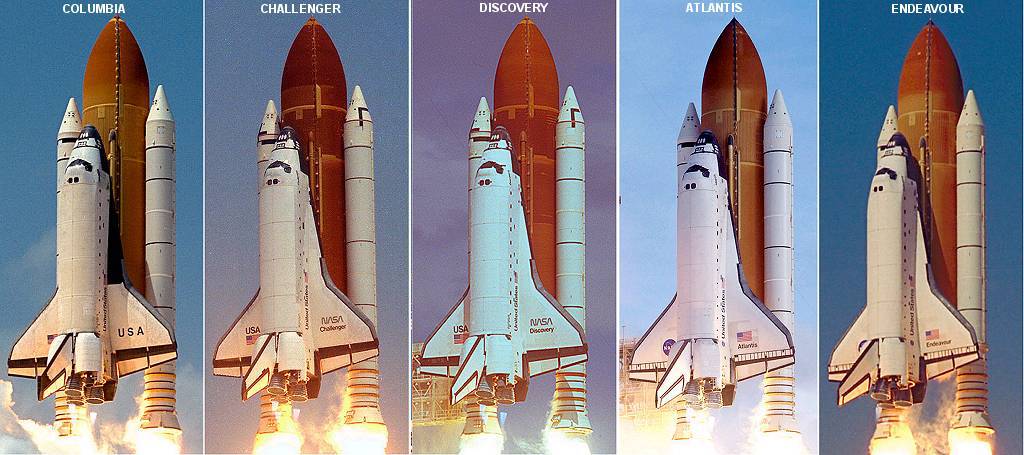
By the first and last flight of the Soviet reusable spacecraft Buran, November 15, 1988, which seemed to confirm the general trend of world cosmonautics towards reusable systems, the first harbinger of the reusable era of the reusable era had already thundered.
January 28, 1986, at 73 seconds of flight, due to problems with one of the side accelerators, the TRU exploded the shuttle Challenger . The death of 7 crew members made it the worst space accident in the history of astronautics (before the Colombian disaster in 2003).
Ice "shower" of reusable cosmonautics. The tragic flight of the shuttle Challenger
Shuttles still flew for 22 years (from 89 to 2011), and even the shuttle Endeavor was built to replace the Challenger. The Energy-Buran program was finally closed in 1993, against the backdrop of economic chaos in Russia.
However, by the end of the 80s, the contours of the future world space exploration, or rather our present, began to emerge. On the promising Russian, Chinese and American super heavy class and will be discussed in the final part of this review.
Part 1. Moon "dinosaurs".
Part 3. "Marstodont" new era.
I strongly advise you to visit the most interesting site Buran.ru , the materials of which are used in this review.
Source: https://habr.com/ru/post/225895/
All Articles